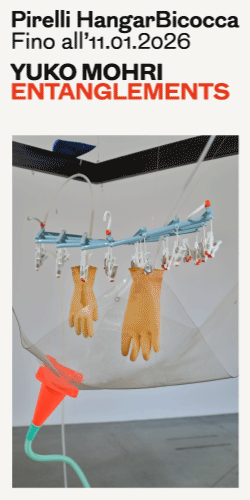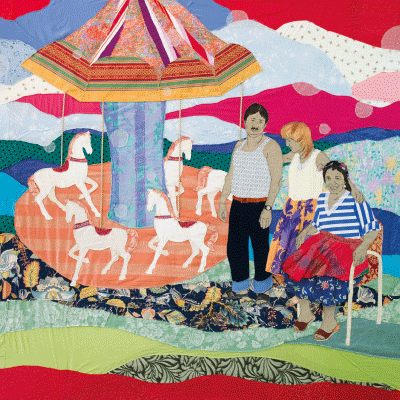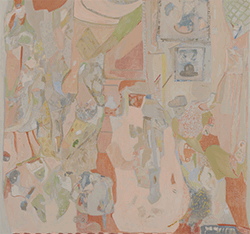[nemus_slider id=”59994″]
Segue testo in italiano
On the 13th of October the exhibition Dayanita Singh. Museum of Machines was open to the public at MAST – Manifattura di arti, sperimentazione e tecnologia in Bologna. This is the first institutional solo exhibition of the master of Indian contemporary photography in Italy (after two participations to Venice Biennale), curated by the curator of MAST photogallery, Urs Stahel.
After having explored for years the field of photojournalism, with her Hasselblad firmly hung to her neck, Dayanita Singh stood out for the expressive strength of her images, visible trough the attention to details, perfect framing, strong contrasts. Her photographs, almost always black and white, portray machines, daily objects, industrial landscapes, archives, workers and common people, in a deep and never banal way. The use of black and white and the choice of her subjects dispel the colonial myths about India, as seen from a western perspective, which should always be exotic, colorful, cheerful and partying; the photographer can then create images that take a distance from what is clearly, and easily, in front of the camera, as declared from the artist herself, who took part to the press conference for the presentation of the exhibition.
The always fast sequence of the images series, even if never fixed but fostered instead to change and transform by the artist herself, creates two particular results; the Storyboards series, whole contact sheets printed on a big size, seeming to represent short motionless films, and the wonderful “photonovels”, images tied by a peculiar narrative and a common subject, where dream and reality mix and where the details become essential. This last kind of work is frequently shown through the use of books. Books are very special for Dayanita Singh, who uses every part of it, from the cover to the back cover, both on a display and narrative point of view, but also on an emotional and cultural level, as an object that can be found in every house and street of the world. Her many books, published by Steidl, are together books and exhibitions, which can change its roles depending on the moment; on exhibit at MAST the series Museum of Chance, a series of 88 portraits and scenes from movies which, printed inside and attached to the cover (on both sides) of 44 books, compose a whole work through their installation, which changes constantly, inside a thin wooden structure that assures the view of every side of the book. This series is then in turn collected inside Suitcase Museum, an installation composed by two leather suitcases where books and their wooden structures are placed for the transport.

And here we find another fundamental crux of Dayanita Singh’s works: display. Some of the photo series are displayed at MAST on the walls – in minimal wooden black frames or natural wooden frames which are a lot deeper, next to some empty nails which are left with no works on them to “leave space” to the unexpected and to the change of display – and in the peculiar Museums invented and built by the artist. This structures, made out of wood and glass, sometimes carriages, sometimes tables, some other times screens, in this case similar to showcases, divided into small squares to contain photographs and which can be closed and arranged exactly like screens, are the “museums” which the artist defines herself as the director of, deciding for their content, position, display, meaning to give them. Derived from the modernist grid, they are intended as sculptures, works per sé that “host” other works, and that allow these last to “move”, changing position and traveling out of the traditional spaces for art, like the shop windows of Park Street in Calcutta, from which Dayanita Singh drew the idea and where her images are displayed, right in some shop windows, since 2008. “Museums give birth to other museums”, says the artist.
The series on exhibit, beyond the aforementioned ones, are drawn from Blue Book, air views of the exteriors of big factories and some intimate interiors, which are the only colors images of the exhibition; Museum of Machines, the larger series, that portrays machines and work spots – from the canteens (series Museum of Industrial Kitchen) to the big hangars of automotive plants to paper mills – and the workers that work inside that factories. These pictures, even if recent, look like they come from the past. Not only for the use of black and white, but also for the “intimistic” gaze of the portraits and shots of the machines that, trough the artist’s eye, look like they have a particular personality; File Museum, a big body of work about archives and archivists; Office Museum, where we find images of offices furniture, which represent in a way power and bureaucracy; Museum of Printing Press, composed by images of printing machines; Museum of Men, portraits of men of every social class – a series realized after the artist was “accused” to only take pictures of women –, to testify the human richness of a very diverse population. Moreover, it will be possible to admire two projections of the artist’s images, Archives and Factories.
The exhibition will be open until January 8th, 2017. MAST is open from Tuesday to Sunday from 10 am to 7 pm. Admittance is free. Not to be missed is, on November 9th, 6.30 pm, in the auditorium of MAST, Aveek Sen, writer and critic who also wrote a text for the exhibition catalog, who will held a conference titled Machines and Emotions, which will deepen the main themes of Dayanita Singh’s works.

Dayanita Singh. Museum of Machines | MAST, Bologna
Il 13 ottobre ha aperto al pubblico presso il MAST – Manifattura di arti, sperimentazione e tecnologia di Bologna la mostra Dayanita Singh. Museum of Machines, prima mostra personale istituzionale in Italia della maestra indiana della fotografia contemporanea, dopo due presenze alla Biennale di Venezia, curata da Urs Stahel, curatore della photogallery del MAST.
Cresciuta professionalmente nel mondo del fotogiornalismo, con la sua Hasselblad saldamente appesa al collo, ben presto Dayanita Singh si è distinta per la forza impressa nelle sue fotografie attraverso i curati dettagli, le inquadrature perfette, i decisi chiaroscuri. Gli scatti, quasi sempre in bianco e nero, ritraggono macchine, oggetti quotidiani, paesaggi industriali, archivi, lavoratori e persone comuni, in modo profondo e mai banale. L’uso del bianco e nero e la scelta dei soggetti sfata i miti coloniali della visione occidentale dell’India, che vuole sempre festante, esotica, colorata, allegra, e cerca così di creare immagini che si allontanino da ciò che è palesemente, e facilmente, posto davanti all’obiettivo, come dichiara la stessa fotografa, intervenuta alla conferenza stampa di presentazione della mostra.
La sequenza sempre serrata delle serie di immagini, pur non essendo fissa ma anzi incoraggiata dall’artista stessa a cambiare e mutare nel corso del tempo, crea poi due particolari risultati; la serie dei cosiddetti Storyboards, cioè interi fogli di fotogrammi in sequenza stampati in grande formato, quasi a rappresentare dei piccoli film immobili, e le bellissime “photonovels”, immagini legate da una peculiare narrativa e da un soggetto comune, in cui sogno e realtà paiono mescolarsi, e dove i dettagli diventano fondamentali. Quest’ultimo tipo di lavoro è presentato frequentemente attraverso l’uso del libro. Il tema del libro è molto caro a Dayanita Singh, che ne utilizza infatti ogni sua parte, dalla prima di copertina alla quarta, sia a livello espositivo che narrativo, ma anche emotivo e culturale, quale oggetto presente in ogni casa e in ogni strada del mondo. I suoi numerosi libri, pubblicati da Steidl, sono al contempo libri e mostre, che a seconda del momento si scambiano di ruolo; in mostra al MAST la serie Museum of Chance, serie di 88 ritratti e immagini tratte da film che, stampate all’interno e applicate sulla copertina (da ogni lato) di 44 libri, compongono un’unica opera attraverso la loro installazione, sempre mutevole, dentro una sottile struttura in legno che permette di vedere ogni lato del libro. Questa serie è poi a sua volta raccolta all’interno di Suitcase Museum, installazione composta da due valige in pelle dove libri e struttura espositiva vengono poi riposti per essere trasportati.

Ed ecco apparire un altro nodo fondamentale del lavoro di Dayanita Singh, l’esposizione. Le altre opere infatti, sono esposte negli spazi del MAST a muro – in cornici minimali in legno nero o cornici in legno naturale di più elevata profondità, accanto a cui sono posizionati chiodi lasciati vuoti per “lasciare spazio” all’imprevisto e al cambiamento del display – e nei particolari Museums inventati e costruiti dall’artista. Queste strutture in legno e vetro, a volte carrelli, a volte tavoli, altre paraventi, in questo caso simili a vetrine, suddivise in piccoli quadrati atti a ospitare le fotografie, e richiudibili e orientabili come paraventi, sono i “musei” di cui l’artista si definisce direttrice, decidendone il contenuto, la posizione, l’allestimento, il significato da assegnare loro. Derivati dalla griglia modernista, essi sono intesi come sculture, opere in sé che “ospitano” altre opere, e che permettono a queste ultime di “muoversi”, cambiando posizione e uscendo dai luoghi deputati all’arte, come le vetrine di Park Street a Calcutta, dove l’artista ha trovato l’idea per i suoi Museums e dove le sue immagini sono esposte, nelle vetrine di alcuni negozi appunto, dal 2008. “Museums give birth to other museums”, i musei danno vita ad altri musei, ama dire l’artista.
Le serie in mostra, oltre alle già citate, sono tratte da Blue Book, viste aeree di esterni di grandi fabbriche e alcuni intimi interni, uniche immagini a colori; Museum of Machines, la serie più nutrita, che da il titolo alla mostra, e che ritrae appunto macchinari e luoghi di lavoro – dalle mense (serie Museum of Industrial Kitchen) ai grandi hangar delle industrie automobilistiche alle cartiere – e gli operai che lavorano all’interno di quelle fabbriche. Queste fotografie, nonostante recenti, sembrano venire dal passato. Non soltanto per l’uso del bianco e nero, ma anche per la visione “intimista” dei ritratti e degli scatti degli utensili che, attraverso gli occhi della fotografa, paiono mostrare una propria peculiare personalità; File Museum, grande lavoro sugli archivi e gli archivisti; Office Museum, dove vediamo ritratti gli arredi degli uffici, che rappresentano in qualche modo il potere e la burocrazia; Museum of Printing Press, composto da immagini di macchine per la stampa; Museum of Men, ritratti di uomini di ogni classe e condizione, serie realizzata dopo che l’artista era stata “accusata” di fotografare solamente donne. Grazie a questa accusa nasce un’intensa galleria di ritratti maschili, a testimoniare la ricchezza umana di un popolo variegato. Inoltre sarà possibile ammirare due proiezioni di immagini dell’artista, Archives e Factories.
La mostra resterà aperta fino all’8 gennaio 2017, a ingresso gratuito, dal martedì alla domenica dalle 10 alle 19; da non perdere l’incontro Machines and Emotions, momento di approfondimento delle tematiche legate all’opera di Dayanita Singh, condotto dal critico e scrittore Aveek Sen (che ha curato anche un testo per il piccolo catalogo della mostra) il 9 novembre alle ore 18.30 presso l’auditorium del MAST.












